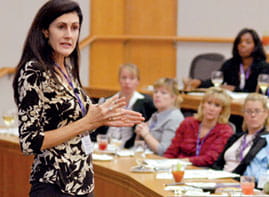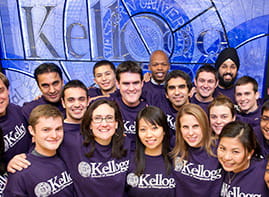Drawing upon his experiences at P&G, President and CEO Bob McDonald outlines 10 characteristics of a great leader
10/14/2009 - Like David Letterman, Bob McDonald has a top 10 list.
On Oct. 7, McDonald, the president and CEO of Procter & Gamble, presented his list of the 10 defining characteristics of a “value-based leader” to Kellogg students in the Owen L. Coon Forum. The list was inspired by experiences that McDonald had over the course of his 20-year career.
McDonald offered his beliefs as a guideline and urged students to develop their own “list” of sorts.
“It is important for each individual and each organization to get in touch with their education, experiences, culture, family heritage and organizational memberships to develop their own set of beliefs,” he said.
1. Lead a life guided by purpose. Only work for a company that you believe in, said McDonald. When looking for a job, examine a company’s purpose, values and people to see if they align with your own beliefs and ethics.
2. Everyone wants to succeed and success is contagious. Treat your employees like they want to succeed, not like they want to fail. “Most of us manage by exception: We wait until someone does something wrong to interact with him or her,” McDonald said. “Spend enough time in your leadership role finding people succeeding.”
3. Put people in the right jobs. McDonald emphasized the importance of identifying your employees’ strengths, and then placing them in roles that feed into those strengths. “At P&G, we have 130,000 employees around the world,” he said. “Imagine what would happen if we put them in jobs that they weren’t good at.”
4. Character is the most important trait of a leader. It’s important for leaders to have integrity and take responsibility for their mistakes. “Choose the harder right, rather than the easier wrong,” McDonald said, citing a prayer that he learned as a cadet at the United States Military Academy at West Point.
5. Diverse groups of people are more innovative than homogenous groups.
Diversity sparks ideas and innovation, so companies must employ a diverse group of people. “We try to plan innovation, but there’s a little serendipity involved,” McDonald said. “Diversity is what helps these nodes to connect.”
6. Ineffective strategies, systems and culture are bigger barriers to achievement than the talents of people.
It’s important to blend a high-performance culture with robust systems and sound strategies, McDonald said. Those ingredients, coupled with technical competencies and a strong company mission, will create a high-performance organization.
7. There will be some people in the organization who will not make it on the journey. Some employees won’t turn out to be a good fit for your company. As head of a company, it’s your responsibility to find the right place for them. “Your job as a leader is to be committed to them as people, not employees,” said McDonald.
8. Organizations must renew themselves. Leaders should always think about what changes are needed to stay relevant in the marketplace and fulfill the company purpose. “Organizations are like biological organisms — they constantly need to change,” said McDonald.
9. Recruiting is a top priority. “Somewhere here is someone who will be giving a presentation here years from now,” said McDonald, pointing to the audience of Kellogg students. “And that excites me.”
10. The true test of a leader is the organization’s performance after the leader departs. If you want to determine whether a leader has been successful, “look at their fingerprints and footprints,” concluded McDonald.
McDonald was appointed president and CEO of P&G on July 1, 2009. He previously served as vice chairman of global operations for the company, where he led sales, information technology, logistics, customer marketing and on-the-ground operations in more than 80 countries. McDonald also previously managed P&G’s business in developing markets, which accounted for 20 percent of company sales.






